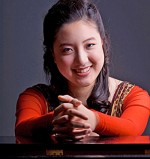Column Name
Title
Improvisation provides everything an aspiring musician could ask for: creativity, confidence, thrill, the ability to mimic musical greats from Bach to Mozart to Liszt, and— according to Juilliard Pre-College Artistic Director Yoheved Kaplinsky (B.M. ’68, M.S. ’69, D.M.A. ’73, piano)—a life free of memory slips. At Juilliard, however, an improvisation course has yet to be implemented, and the Pre-College did not provide any improvisation courses until last year.
Body
I was one of the few students to take that inaugural Pre-College improvisation course, Piano Improvisation, and to perform in its final concert in May, along with my classmates Yun-Chih Hsu, Tiffany Poon, Sarina Zhang, and instructor Noam Sivan (D.M.A. ’10, composition). The concert included a two-piano Impressionist piece, a cello-piano duet in two movements, and several other improvised creations. It was the first time many piano students had heard pure improvisation performed on any stage.
“It was so different from how we normally perform in the Pre-College,” Sarina, now a first year pianist at Juilliard, commented after the recital. She had expected positive feedback from the audience precisely because “they didn’t know what kind of music they would hear,” and we did end up getting a positive reaction—parents, teachers, and students commended us for our power, confidence, and natural demeanor. On the first day of improvisation class, however, the words improvise and natural seemed quite incompatible. That day, my peers and I sported awkward laughs, uncharacteristic shyness, and, most shockingly, a genuine fear of playing the piano. Never mind that we were all accomplished pianists who had showcased our talents all over the world and whose repertoire spanned centuries—when asked to bring something of our own from the instrument, we were flummoxed.
Were those years of confining ourselves to a practice room and memorizing vast solo and concerto repertoire useless? Not at all—they were simply not enough.
As Sivan made clear within the first few weeks of class, improvisation and written music are interdependent, and without both components, true musicianship would be incomplete. He guided us through detailed score study, explaining the applications of elementary music theory (modulations, intervals, circle of fifths) to these scores and to our improvisation. For inspiration, we analyzed Bach sarabandes, Haydn string quartets, Chopin nocturnes, and Mozart concerto cadenzas—we were even given the opportunity to compose and perform our own cadenzas for the concerto of our choice.
Those who yearn to venture immediately into wild, atonal territory upon taking the class will realize the importance of building a strong foundation first. One may scoff at the idea of improvising a minuet; however, Baroque and Classical improvisation pose substantial mental challenges due to their tonal limitations. Imagine writing four-part counterpoint, but five times faster—maintaining acute awareness of parallel fifths and eighths, non-chord tones, and modulations from one second to the next.
As a result, my peers and I have gained not only a more thorough understanding of the composition process, but also the humbling revelation that any given written piece is simply a “well-organized improvisation,” an improvisation that has undergone multiple polishings. In fact, throughout the year we asked many of the same questions that composers do: What makes a good melody? When and how should I modulate? What constitutes the best transitions between contrasting textures?
Such fluid, spontaneous composition comes only with—yes, that’s right—practice. The notion of practicing improvisation seems contradictory; as my younger sister once eloquently asked, “How do you practice making up stuff?” As musicians well know, however, practice is necessary to make any skill innate and natural, and the skill of musical spontaneity is no exception. Tiffany describes improvisational practice not as playing the same passage over and over, but rather as “improvising until one is comfortable.” Yun-Chih emphasizes the importance of “listening to all kinds of musical styles” to drive and inspire improvisation practice—hinting once again at the relationship between improvisation and written music.
In Tiffany’s description, we find the key word: comfort. A peculiar but common trait among those who improvise is that they seldom look like they are improvising at all, since they are so relaxed. The comfort gained through improvisation definitely resonates through all walks of life, not just through music. “The class taught us how to be more open, more relaxed, and more willing to take chances,” Sarina said, “and definitely strengthened my overall personal goal of accepting, rather than fighting, whatever obstacles appear.”
In light of the immense benefits of improvisation, why do so few pianists engage in improvisation today? I believe that the answer to this question has two parts. First, due to the great ambiguity present when engaging with an audience or a competition jury, musicians tend to find comfort only in the known and the pre-written, rather than in unknown, unexplored, and unpredictable musical territory. Second, the indispensable relationship between improvisation and pre-written music has been overlooked in recent years, and many musicians do not recognize that frequent opportunities exist to investigate this relationship in depth. To be able to break these barriers to knowledge and experience as a young musician could be not only simple, but also truly rewarding.
Faculty member Noam Sivan will give a Doctoral Forum called Improvisation in Classical Music: Past and Present on October 29 at 5 p.m. in Morse Hall.





